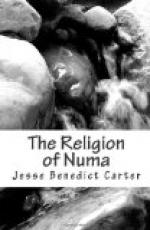The centre therefore of early religious life is the family, and the state as a macrocosm of the family; and the father of each family is its chief priest, and the king as the father of the state is the chief priest of the state. As for the individual the only god which he has for worship is his “double,” called in the case of a man his Genius and in that of a woman her Juno, her individualisation of the goddess Juno, quite a distinct deity, peculiar to herself. But even here the family instinct shows itself, and though later the Genius and the Juno represent all that is intellectual in the individual, they seem originally to have symbolised the procreative power of the individual in relation to the continuance of the family. The family and the state, however, side by side worshipped a number of deities.
In the primitive hut, the model of which has come down to us in so many little burial urns of early time (for example those that have recently been dug up in the wonderful cemetery under the Roman Forum), with its one door and no window, there were several elements which needed propitiation; the door itself as the keeper away of evil, the hearth, and the niche for the storage of food. The door-god was the god-door Janus, the ianua itself; the hearth was in the care of the womenfolk, the wife and daughters, so it was a goddess, Vesta, whom they served; and the storage-niche, the penus, was in the keeping of the “store-closet gods” (Di Penates). The state itself was modelled after the house. It had its Janus, its sacred door, down in the Forum, and the king himself, the father of the state, was his special priest; it had its hearth, where the sacred fire burned, and its own Vesta, tended by the vestal




